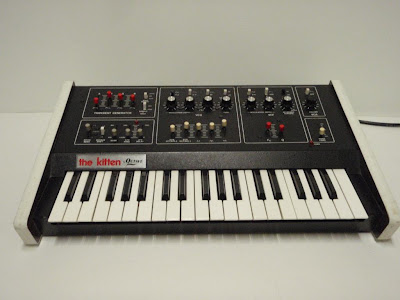
via
this auction

"Groove on the move with this DJ effects processor! Since it first appeared, the KAOSS Pad series effects processor has been enormously popular with artists around the world for its intuitive touch-pad interface and its revolutionary effect programs. Now, the series is joined by its smallest member, the Korg DJ effects processor called the miniKP.

While providing the same interface in which multiple parameters of the effect program are controlled by a single fingertip, the miniKP effects processor brings the advantages of battery operation and mobility, making it an ideal choice for DJ club performances, home studio applications, as well as outdoor live events or for use with a portable audio player. Wherever you are, the mini-KP brings new possibilities to any music scene.

The miniKP is a lightweight effects processor, yet offers tons of features like auto-BPM and Tap Tempo functionality, FX hold, FX depth selection, FX Release and more - all derived from its big brother, the KP3.

Meant To Be Touched
The miniKP's size and power make it a perfect multi-task effects processor. Keep it near your studio and patch it into the effects loop of a guitar amplifier, directly between a synth and mixer or some other creative position. No matter what you connect it to, from a mixer to an MP3 player or directly to your television set, the Korg miniKP provides the effects you need to get the job done - or simply have some fun!
Programs:
100

Effects:
LPF (Low Pass Filter), HPF (High Pass Filter), BPF+ (Band Pass Filter+), 72dB/oct LPF, LPF & Delay, HPF & Delay, BPF+ & Delay, LPF & Reverb, HPF & Reverb, BPF+ & Reverb, Morphing Filter, Radio Filter, Radio Isolator, Isolator, Isolator & Distortion, Isolator & Delay, Jet (Manual Flanger), Manual Phaser, Talk Filter, Digi Talk, Ring Mod & HPF, Pitch Shifter & HPF, Mid Pitch Shifter, Pitch Shifter & Delay, Broken Modulation, Fuzz Distortion, Decimator, Decimator & HPF, LFO LPF, LFO HPF, LFO BPF+, LFO HPF+ & Delay, Infinite LFO HPF+, Random LFO LPF, Random LFO HPF+, Flanger, Deep Flanger, Mid Flanger, Flanger & LPF, Flanger & Delay, Infinite LFO Flanger, Phaser, Mid Phaser, Phaser & Delay, Step Phaser, Auto Pan, Mid Auto Pan, Slicer, Mid Slicer, Slicer & LPF, Slicer & HPF, Delay, Smooth Delay, Low Cut Delay, Ping Pong Delay, LCR Delay, 3 band Delay, Multi Tap Delay, BPF Time Slide, Reverse Delay & HPF, Reverse Delay Mix, Gate Reverb & Delay, Delay & Reverb, Tape Echo, Dub Echo, Feedback Echo, Reverb, Reverb 2, Spring Reverb, Gate Reverb, Reverse Gate Reverb, 3 band Gate Reverb, Grain Shifter, Mid Grain Shifter, Mid Grain Shifter+, Grain & HPF, Grain & HPF+, Looper Forward/Reverse, Vinyl Looper, Rewind Spin Looper, Looper & LPF, Looper & HPF, Looper & Flanger, Looper & Pitch Shifter, Looper & Decimator, Looper Isolator & HPF, Looper & Isolator+, Bass Looper, Looper & Oscillator, Looper & Noise, Unison Saw Bass, Unison Squ Bass, Unison Saw Synth, Unison Squ Synth, Metalic Synth, Siren, LFO Sin, LFO Squ, Noise, Synth & Looper
Connectors:
LINE IN jacks (RCA phono jacks), LINE OUT jacks (RCA phono jacks), HEADPHONES jack (stereo mini jack)
Sampling Frequency:
48kHz
AD/DA:
24-bit linear
Power Supply:
four alkaline AA (LR6) batteries (6 V)
Battery Life:
approx. five hours (with alkaline batteries)
Dimensions:
4.17 (W) x 5.08 (D) x 1.14 (H) inches/
106 (W) x 129 (D) x 29 (H) mm
Weight:
154 g / 5.43 oz. (without batteries)
Included Item:
Four AA batteries
Optional Accessories:
AC adapter model – 405012500/KA193 (Sold separately)
4.5V 500ma Center Pin (+)"
iw5g~~_12.JPG)























































